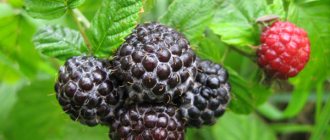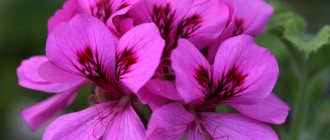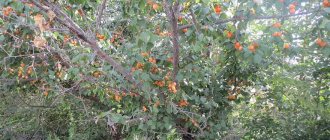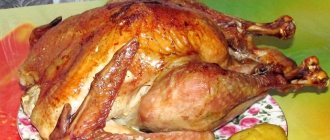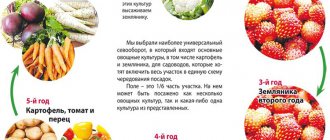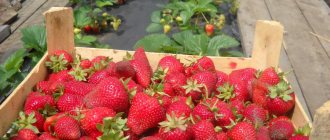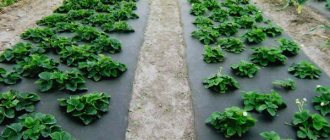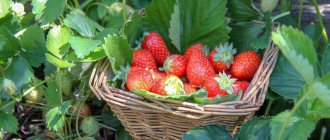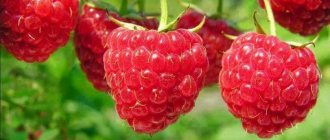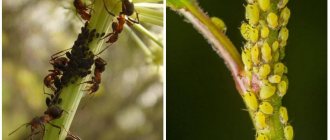| Strawberries | ||
| Left - Wild strawberries, right - Meadow strawberries | ||
| Scientific classification | ||
| intermediate ranks Domain: | Eukaryotes | |
| Kingdom: | Plants |
| Sub-kingdom: | Green plants |
| Department: | Flowering |
| Class: | Dicotyledons[1] |
| Superorder: | Rosanae |
| Order: | Rosaceae |
| Family: | Pink |
| Subfamily: | Rosanovye |
| Tribe: | Potentilleae |
| Subtribe: | Fragariinae |
| Genus: | Strawberries |
, 1753
Type species Fragaria vesca, 1753| NCBI | 3746 |
| EOL | 29917 |
| GRIN | g:4744 |
| IPNI | 30014957-2 |
Strawberry
(lat. Fragária[2]) is a genus of perennial herbaceous plants of the Rose family (
Rosaceae
).
Includes both wild-growing species (wild strawberry, lowland strawberry, eastern strawberry, meadow strawberry, garden strawberry, etc.) and species that do not exist in the wild (for example, pineapple strawberry, often colloquially called strawberry). There are also species that exist in wild and cultivated forms (for example, nutmeg strawberry, wild strawberry).
Spreading
Representatives of the genus, which probably arose in the Tertiary period, are distributed in Eurasia and America. The most ancient are diploid species F. vesca, F. viridis, etc. They are of circumpolar origin (Zhukovsky P. M., 1971). In general, the center of origin and initial development of the genus is considered to be East Asia, where diploid and first tetraploid species arose. Subsequently, the species spread and penetrated into Europe and America.
Some species penetrated into the mountainous regions of the tropics and Eurasia (including the Himalayas), as well as into Japan[8].
Vitamins in strawberries and wild strawberries: where is there more?
It's no secret that berries are rich in microelements, antioxidants and other useful components. Strawberries contain vitamins: C, E, A, B. Strawberries are a storehouse of C, E, B, H, PP. The highest concentration of vitamins is found in wild berries.
In addition, a considerable amount of minerals and antioxidants are found in the leaves of plants. For example, strawberry decoction is used for the following diseases:
- Enterocolitis
- Underweight
- Pathologies of the spleen
- Atherosclerosis
- Hypertension
- Constipation
- Haemorrhoids
- If there are parasites
- Frequent acute respiratory infections
- Ulcer
Strawberry leaves and fruits are widely used in the presence of the following diagnoses:
- Pharyngitis
- acute respiratory infections
- Laryngitis
- Inflammation of hemorrhoids
- Stomatitis
- Depression
- Intestinal disorder
- Poisoning
- Streptococcus
Properties of the berry
Vitamins and microelements are contained in approximately equal quantities in these berries. However, it is worth remembering that when choosing strawberries for medicinal purposes, it is necessary to choose those that have grown in the wild, or those fruits for the growth of which chemical fertilizers and pesticides were not used.
Botanical description
Garden strawberry seeds (nuts)
Leaves are trifoliate, complex in shape, on long stems reaching a height of 10 cm; creeping, rooting shoots.
The root system is fibrous, the depth of the roots is 20-25 cm.
The inflorescence is a multi-flowered shield. Flowers, as a rule, are bisexual, pollinated by insects, located on long peduncles that extend from the root collar in a rosette. The petals are usually white, sometimes yellowish; many stamens and pistils.
Strawberry fruits are apocarpous (that is, complex, or composite), they are false berries (multi-nuts) like frags, or strawberries [9][10][11]. Small brownish seeds are located on the surface of an overgrown succulent receptacle.
Flowering of strawberries in the central zone of the European part of Russia continues from the end of May until the fruit begins to ripen (usually the beginning of July).
Strawberry species are divided into 4 groups based on the number of chromosomes (Darrow, 1966; Scott and Lawrence, 1981)[7]:
- diploids (2n = 14) - F. vesca L. (3. forest), F. viridis Duch. (3. green), etc.;
- tetraploids (2n = 28) - F. corymbosa Los. (3. corymbose), F. moupinensis, (Franch.) Card. (3. moupinensis), F. orientalis Losinsk. (3. eastern);
- hexaploids (2n = 42) - F. moschata Duch. (3. musky);
- octaploid (2n = 56) - F. virginiana Duch. (3. Virginian), F. chiloensis (L.) Duch. (3. Chilean), F. x ananassa Duch. (3. pineapple), F. ovalis (Lehn.) Rydb. (3. oval), etc.
The study of phenolic compounds in berries of species from these groups confirmed the phylogenetic relationships between species established by cytologists (Scott et al., 1981).
The octoploid level (2n = 58) is the maximum for wild species. Decaploids (2n = 70) and higher ploidy levels (2n = 84 and 98) are synthesized by humans[8][10]. Distinctive features of some wild strawberry species
[12]
| Signs | Wild strawberry | Musk strawberry | Green strawberries | Plain strawberry |
| Stem height, pubescence | 5-20 cm, hairs pressed | 25-32 cm, protruding hairs | 5-25 cm, hairs pressed | 5-10 cm, protruding hairs |
| Flowers | Bisexual, sepals horizontal or recurved | Unisexual, sepals bent back | Bisexual, fertile and sterile, sepals appressed | Sepals not appressed or protruding |
| False berries | Bright red, nuts protrude from the pulp | Pink, crimson or white, the nuts are immersed in the pulp, absent at the base | Red or pink, with a pubescent top, nuts protrude from the pulp | Red, nuts immersed in pulp |
Lieutenant Schmidt variety
In conclusion, I would like to say a few words about a fashionable novelty - “curly” strawberries. Advertisements for this miracle plant appear in the media every now and then, accompanied by colorful photos in which there are more berries than leaves. Let's dot the i's in this matter. Firstly, from a biological point of view, climbing strawberries cannot exist. Secondly, what you see in the picture is, in most cases, a photomontage. Indeed, strawberries are sometimes grown in vertical containers (most often in greenhouses); in some cases, rosettes can bear fruit, receiving nutrition from the mother plant. In this case, it may seem that the plants are climbing along a vertical surface. There is no need to believe colorful advertising and pay a lot of money for no reason. “Climbing” strawberries do not exist in nature. Just like “standard” raspberries. But that's a completely different story...
Taxonomy
Genus Strawberry
is part of the subfamily
Rosoideae
Rosaceae
family
Rosales
order .
| 8 more families (according to the APG II System) | 39 more births | |||||||||||||
| order Rosaceae | subfamily Rosoideae | |||||||||||||
| about 20-100 species (according to different authors) | ||||||||||||||
| Department Flowering, or Angiosperms | Rosaceae family | genus Strawberry | ||||||||||||
| another 127 orders of flowering plants (according to the APG II System) | 3 more subfamilies (according to the APG II System) | |||||||||||||
Kinds
Fruits of wild strawberries (left) and pineapple strawberries (right)
Strawberry fruits
According to The Plant List for 2013, the genus includes 17 species[13]:
- Fragaria ×ananassa (Duchesne Weston) Duchesne ex Rozier - Pineapple strawberry, or Garden strawberry, or Large-fruited strawberry[14]
- Fragaria chiloensis () Mill. — Chilean strawberries[14]
- Fragaria crinita Rydb.
- Fragaria daltoniana J.Gay
- Fragaria gracilis Losinsk.
- Fragaria iinumae Makino - Iinuma Strawberry, or Sakhalin Strawberry *
- Fragaria iturupensis Staudt
- Fragaria moschata (Duchesne) Duchesne - Musk strawberry, or Garden strawberry[14]
- Fragaria moupensis (Franch.) Cardot
- Fragaria moupinensis (Franch.) Cardot
- Fragaria nilgerrensis Schltdl. ex J.Gay – Nilgerian strawberry[14]
- Fragaria nubicola (Lindl. ex Hook.f.) Lacaita - Tibetan strawberry[15]
- Fragaria orientalis Losinsk. — Oriental strawberry[14]*
- Fragaria pentaphylla Losinsk. — Five-leaf strawberry[15]
- Fragaria vesca L. typus - Wild strawberry, or Alpine strawberry[15]*
- Fragaria virginiana Mill. — Virginia strawberry[15]
- Fragaria viridis Weston - Green strawberry, or Meadow strawberry, or Polunitsa[15]*
Asterisks indicate wild species growing in Russia[10].
What are strawberries and strawberries, and what do they look like?
Strawberry and wild strawberry plants belong to the Strawberry genus of the Rosaceae family. They are similar in appearance, but have a number of distinctive qualities.
- The fruits of ripe strawberries are scarlet in color.
- The shade of ripe strawberry fruits can vary from red to dark brown
- Strawberries look like a small bush (20-25 cm), which consists of several stems in the center and leaves along the side edges
- Strawberries look like a mundane bush and range in height from 25 to 32 cm, depending on the variety. There are leaves on the sides, and “tendrils” stretch along the center of the ground - stems, thanks to which the process of reproduction occurs
- The fruits of garden strawberries are larger than those of wild strawberries
Type of strawberry
- Strawberries are usually large, about 2-7 cm, depending on the variety
- Small strawberry fruits: 0.5-2 cm
- Garden strawberries can reach 2-4 cm in size
- When cut, the strawberry has white tissue inside, a stem and seeds along the entire outside.
- Strawberries also have seeds on the outside of the fruit, and the inside is a rich red color.
- The fruits of garden strawberries do not have bitterness, unlike wild strawberries.
Economic importance and application
In culture
Strawberries were introduced into cultivation in the 15th–16th centuries. Cultivated species as fruit:
- pineapple strawberry ( Fragaria × ananassa
), to which the name
strawberry
(although in biological nomenclature this name belongs to a plant belonging to a different biological species)[16]. It is the most common type of strawberry in cultivation. - wild strawberry ( Fragaria vesca
), cultivars often called
alpine strawberry
. - Muscat strawberry, or musk strawberry ( Fragaria moschata
), which is correctly called strawberry[3][16][16][17][18][19][20][21]. - green strawberry ( Fragaria viridis
), growing wild in central Russia, which was originally called strawberry, now called
polunitsa
.[3] - Virginia strawberry ( Fragaria virginiana
). - Chilean strawberry ( Fragaria chiloensis
).
The receptacle of strawberries contains up to 150 mg/100 g of vitamin C, calorie content - about 40 kcal/100 g, carbohydrates - about 8 g, proteins - up to 2 g. The receptacle is a relatively strong allergen when eaten.
Wild growing
Wild species are also used as fruit plants, but most often the collection is not carried out on an industrial scale. Wild strawberry ( Fragaria vesca
) - is, in addition, a medicinal plant[22][23][24].
Spanish strawberry or spanka (Fragaria moschata)
Spanish strawberry or spanka is another name for domesticated strawberry, more popularly known as strawberry. This variety of strawberry was brought to Russia from Europe. Initially, only green strawberries were grown and eaten in Rus'.
Shpanka strawberry bushes are tall, sometimes reaching even 40 cm in height. They grow quite strongly, sending out mustaches in all directions. The flowers are located in the same plane, often bisexual inflorescences are found on one plant.
Some of the most popular varieties:
- Joseph Mohammed;
- Alba;
- Octave;
- Malvina;
- Bohemia.
Spanish strawberries usually have good resistance to frost and can also tolerate extreme heat. Some varieties are capable of bearing fruit either for a very long time in a row, or several times a season.
Information about strawberries in Russia at the end of the 19th - beginning of the 20th centuries
Strawberries
(
Fragaria vesca L.).
This name is also used in our country for the species F. elatior
Ehrh., as well as others bred in gardens.
Strawberry culture began quite recently, namely from, and in some places from the 16th century. The Greeks and Romans did not engage in this culture. First of all, they started breeding real or. forest green (F. vesca). It was even transported to hot countries, where it was well accepted and spread in mountainous areas. So on the island of Bourbon in 1801, it grew so abundantly in places that during the ripeness of its fruits it was impossible to step without staining your feet with red pulp. American species were transferred to Europe relatively late: the Virginian one came to England only in 1629, and the Chilean one was introduced into France in 1715. Now the best varieties being bred are derived from a cross between American and European forest varieties and others. In Russia, greenery culture began even later, perhaps partly due to the fact that it was born here in extraordinary abundance: forest - in the north. and central Russia, a Fr.
collina (steppe strawberry) - in the east.
and south Russia, where it is especially aromatic and so abundant that the milk of mares grazing on the untouched steppe meadows sometimes has a strawberry aroma. No one, however, has tried to grow steppe strawberries artificially. Back in the forties of our ( XIX
) century, breeding of Z. in Russia was limited almost exclusively to Moscow, St. Petersburg and Western.
regions. A. Beketov. (Encyclopedia of Brockhaus and Efron. - St. Petersburg: Brockhaus-Efron. 1890-1907.)
“In the Russian language of the 19th century. the plant Fragaria vesca was called strawberry, and Fragaria moschata was called strawberry. With the wide spread of the berry, which in the specialized literature is called garden strawberry, obtained by the hybridization of two American species of Fragaria, in Moscow and St. Petersburg (where Fragaria moschata was almost unknown) it began to be called strawberry, in the Volga region, which abounds in strawberries (Fragaria viridis) - Victoria , named after one of the first varieties of garden strawberries.”
“Comparison of St. Petersburg with Moscow and other considerations on social lexicography” - V. I. Belikov. Institute of Russian Language RAS. (Russian language today. - Issue 3. Problems of Russian lexicography. - M.: Institute of Russian Language of the Russian Academy of Sciences, 2004. - P. 23-38)
Remontant varieties of strawberries
The main difference between remontant varieties is long-term fruiting. Some varieties are harvested from May to September.
Additionally, we recommend that you read the information on growing remontant strawberries from seeds.
Queen Elizabeth
A productive variety from England. The first berries are harvested at the end of May, and the last ones in the fall, before the onset of the first frost.
Varietal characteristics:
- The fruits are large (35-55 g), bright red.
- Smooth and round in shape.
- The taste is sweet, juicy, honey.
The first harvest is harvested at the end of May, the second in July-August, and the last in October. From one bush you can collect up to 1.5 kg of berries. In cool weather, the berries stretch out and become larger.
Subtleties of care:
- Plant in sunny areas 30cm apart. The distance between the beds is 55-60 cm.
- Apply organic fertilizers during fruiting. In spring, fertilize with nitrogen compounds.
- Water once every 2-3 days. After irrigation, loosen the soil.
“Elizabeth” is resistant to spotting, gray rot, and powdery mildew, but is vulnerable to insect pests - strawberry mites, spider mites, and weevils.
Geneva
A productive variety from America. After the first harvest (in early June), the strawberries rest. The second fruiting occurs in early July. Then, after the formation of the seventh leaf, the plant pleases with berries until frost.
Varietal characteristics:
- The berries are red-cherry in color.
- Fruit weight 40-50 g.
- The shape is semicircular, pointed.
- The taste is juicy and sweet.
By the end of the growing season, the berries become almost 2 times smaller, but this does not affect the taste. "Geneva" is valued for its persistent, rich strawberry aroma.
Subtleties of care:
- The most favorable planting dates are May and mid-August - late September. "Geneva" grows well in loamy soils and soils with a neutral reaction.
- To increase the second harvest, remove spring flower stalks.
- Water generously by drip.
- Cover the beds for the winter.
Resistant variety to fungi and viruses, spider mites. Gray rot is dangerous for the plant.
Temptation
Cascade remontant variety from Italy. Harvest from June until the first frost.
Varietal characteristics:
- The berries are glossy, dark red. Average weight 20-30 g.
- The shape is round, tapering towards the end.
- The taste is sweet, juicy. The aroma is nutmeg.
“Temptation” is a high-yielding crop. Up to 1.5 kg of berries are harvested from one bush. Due to their dense texture, the berries are canned, frozen, and used in cooking.
Subtleties of care:
- Plant in areas with adequate light. The variety loves fertile soils.
- Strawberries need watering and fertilizing.
- Remove excess mustache from thickening the bushes.
- For the winter, prune the bushes (not at the root) and cover them.
“Temptation” serves as a decoration for the garden. Some gardeners grow bushes in pots, where they hang beautifully along with the berries.
Selva
An early remontant variety from the USA. Fruiting occurs in waves from May to October.
Varietal characteristics:
- The berries are scarlet, glossy, large.
- The weight of the fruit is large, from 20 to 70 g.
- The shape is smooth, round.
- The taste is strawberry, sweet and sour.
In taste and aroma, “Selva” is inferior to other remontant species, but it has good transportable qualities.
Subtleties of care:
- The first harvest is not sweet enough, so the flower stalks are removed.
- At the beginning of growth and flowering, on hot and dry days, water the strawberries generously.
- Feed Selva regularly with mineral and organic fertilizers.
This variety is not afraid of powdery mildew, spotting, or gray rot. Withstands frosts up to 20 degrees.
In order to grow strawberries in your summer cottage, you need to take into account not only personal preferences, but also climatic conditions. Breeders have developed so many varieties that choosing strawberries even for a harsh climate is not difficult.
0
0
Copy link
Interesting Facts
- When translating the names of some widespread types of strawberries from other languages, it should be taken into account that garden strawberry ( Fragaria ananassa Duchesne
) in English is “Strawberry”, in French - “Fraise”;
Strawberry (garden) ( Fragaria moschata Duchesne
) in English - “Musky strawberry”, in French - “Fraise capron”;
Wild strawberry ( Fragaria vesca Linnaeus
) in English - “Wild strawberry” or “Alpine strawberry” (Alpine strawberry), in French - “Fraise des bois” [25].
How to distinguish wild strawberries from strawberries by leaves?
To distinguish strawberries from garden strawberries, just look at the leaves of the plant. However, it is not only by external data that one can determine the type of berry. Strawberries have the following characteristics:
- Peduncles are located significantly higher than the foliage
- The berries are not tilted downwards
- Leaves and fruits have a musky aroma
- Plants are grown in the shade in places with high humidity
- The leaves are corrugated or light green, but they are always large
Strawberry leaves
Strawberry has the following qualities:
- The leaves are oval, ovate, trifoliate or ovate-rhombic in shape.
- The edges of the leaves are always serrated
- Their shade is usually a rich green color.
- Leaves are large or medium, depending on the bush
- The bottom of the leaf is always omitted
- Leaves and fruits are always fragrant
Notes
- For the convention of indicating the class of dicotyledons as a superior taxon for the group of plants described in this article, see the section “APG Systems” of the article “Dicotyledons”.
- The Latin generic name comes from Lat. fragare - to smell fragrant.
- ↑ 123
What berry do many Russians call their favorite, without even knowing its taste?, School of Life - educational magazine. - strawberries // Etymological Dictionary of the Russian Language = Russisches etymologisches Wörterbuch: in 4 volumes / author.-comp. M. Vasmer; lane with him. and additional member-corr. USSR Academy of Sciences O. N. Trubachev, ed. and with a preface. prof. B. A. Larina [t. I]. — Ed. 2nd, erased - M.: Progress, 1986-1987.
- Strawberries, Information portal on gardening, floriculture and landscape design
- Hieronymus Bock.
New Kreuterbuch von Underscheidt, Würckung und Namen der Kreuter, so in teutschen Landen wachsen. - Strasbourg, 1546. - ↑ 12
Strawberries and strawberries, G. F. Govorova, D. N. Govorov. Russian State Agrarian University - Moscow Agricultural Academy named after. K. A. Timiryazeva. Prospect LLC, 2015 UDC 634.75(043)+631.95(043). - ↑ 12
Strawberries, GREEN WORLD. - Medical botany, Serbin A. G., Seraya L. M., Tkachenko N. M., Slobodyanyuk T. A., 364 pp., 2003
- ↑ 1 2 3 Strawberries
- article from the Great Soviet Encyclopedia. - Yagoda
- article from the Great Soviet Encyclopedia. - Ivashin, D. S. et al.
Medicinal plants of Ukraine. - K.: Harvest, 1974. - P. 142. - Species in Fragaria
(English).
The Plant List (2013).
Version 1.1. Published on the Internet; https://www.theplantlist.org/ . Royal Botanic Gardens, Kew and Missouri Botanical Garden (2013). Retrieved November 5, 2014. - ↑ 1 2 3 4 5
Russian name of the taxon - according to the following edition:
Shroeter A.I., Panasyuk V.A.
Dictionary of plant names = Dictionary of Plant Names / Int. union biol. Sciences, National Faculty of Biologists of Russia, Vseros. Institute of Lec. and aromatic plants Ros. agricultural academies; Ed. prof. V. A. Bykova. - Koenigstein: Koeltz Scientific Books, 1999. - P. 319. - 1033 pp. — ISBN 3-87429-398-X. - ↑ 1 2 3 4 5
Russian name of the taxon - according to the following edition:
Shroeter A.I., Panasyuk V.A.
Dictionary of plant names = Dictionary of Plant Names / Int. union biol. Sciences, National Faculty of Biologists of Russia, Vseros. Institute of Lec. and aromatic plants Ros. agricultural academies; Ed. prof. V. A. Bykova. - Koenigstein: Koeltz Scientific Books, 1999. - P. 320. - 1033 p. — ISBN 3-87429-398-X. - ↑ 1 2 3 Strawberries
- article from the Great Soviet Encyclopedia. - Club 2: Strawberry // Explanatory dictionary of the living Great Russian language: in 4 volumes / author's compilation. V. I. Dal. — 2nd ed. - St. Petersburg. : Printing house of M. O. Wolf, 1880-1882.
- Strawberry (inaccessible link), “School etymological dictionary of the Russian language.” Origin of words. — M.: Bustard. N. M. Shansky, T. A. Bobrova, 2004
- Strawberry // Etymological Dictionary of the Russian Language = Russisches etymologisches Wörterbuch: in 4 volumes / author.-comp. M. Vasmer; lane with him. and additional member-corr. USSR Academy of Sciences O. N. Trubachev, ed. and with a preface. prof. B. A. Larina [t. I]. — Ed. 2nd, erased - M.: Progress, 1986-1987.
- Club // Etymological Dictionary of the Russian Language = Russisches etymologisches Wörterbuch: in 4 volumes / author.-comp. M. Vasmer; lane with him. and additional member-corr. USSR Academy of Sciences O. N. Trubachev, ed. and with a preface. prof. B. A. Larina [t. I]. — Ed. 2nd, erased - M.: Progress, 1986-1987.
- Fragaria elatior // Botanical dictionary / author's compilation. N. I. Annenkov. - St. Petersburg. : Imp. Academy of Sciences, 1878. - P. 146.
- Blinova, K. F. et al.
Botanical-pharmacognostic dictionary: Reference. allowance / Under (inaccessible link) ed. K. F. Blinova, G. P. Yakovleva. - M.: Higher. school, 1990. - P. 190. - ISBN 5-06-000085-0. - Wild strawberry (Fragaria vesca), Medicinal plants and herbs, photos, description, application, properties, treatment.
- Fragaria vesca L. Rosaceae family, Article on the website greenrussia.ru
. - 42-44/Fragaria ananassa Duchesne/Strawberry (en)/Fraise (fr)/Garden strawberry (rus), GOST 27521-87. "Fruits. Nomenclature. First list."
What is healthier, better, more productive, more aromatic, tastier: strawberries or strawberries?
There are about 30 varieties of strawberries. The most popular varieties are:
- Sadovaya
- Lesnaya
- Chilean
- Eastern
- Virginskaya
- Large-flowered
The most popular strawberry varieties include:
- Gigantella
- Mara de bois
- Albion
- Mashenka
- Festival
- Marvelous
- Maksim
- Lord
- Honey
- Kimberly
Selecting a variety
When choosing berries for cultivation, you should consider:
- Garden strawberries produce more fruit than strawberries
- Strawberries are more flavorful
- Strawberries are sweeter
- Strawberries have a sour aftertaste
- Both berries can be used as a base for preparing various dishes.
- Strawberries are smaller in size
Unambiguously answer the question: “Which berry is healthier and tastier?” - impossible. After all, each variety has a number of specific qualities that distinguish it from the rest.
Literature
- Fragaria // Botanical dictionary / comp. N. I. Annenkov. - SPb.: Type. Imp. AN, 1878. - XXI + 645 p.
- Strawberry // Encyclopedic Dictionary of Brockhaus and Efron: in 86 volumes (82 volumes and 4 additional). - St. Petersburg, 1890-1907.
- Vavilov N.I.
Centers of origin of cultivated plants.
— L.: Type. them. Gutenberg, 1926. [ page not specified 1549 days
] - Five continents / N. I. Vavilov. Under the tropics of Asia / A. N. Krasnov. - M.: “Mysl”, 1987. - 348 p.
- Biological encyclopedic dictionary. — Ed. 2nd, corrected. Ch. editor: Gilyarov M. S.; Editorial team: Baev A. A., Vinberg G. G., Zavarzin G. A., etc. - M.: “Sov. Encyclopedia", 1989.
- Zhukovsky P. M.
Cultivated plants and their relatives: Systematics, geography, cytogenetics, immunity, ecology, origin, use. — Ed. 3rd, revised and additional - L.: Kolos, 1971. - 752 p. - Filosofova T. P.
Strawberries. - M.: Moscow worker, 1962. - 138 p. — 50,000 copies. - Filosofova T.P.
Strawberry varieties for the non-chernozem zone. - M.: Publishing house Moscow. University, 1970. - 104 p. — 30,000 copies.
Victoria
The name refers to the first Russian garden strawberry. An American variety called Victoria was brought to us in the 18th century. As a result, the plant began to be called by gardeners. In fact, Victoria and strawberry are different species.
More on the topic: Strawberries of the Divnaya variety
Secrets of technology and agricultural technology for growing garden strawberries (with video)
The agricultural technology of garden strawberries is quite simple, but since the plants originate from southern latitudes, science has established that the optimal soil temperature for growth and good functioning of roots is about 26 degrees Celsius (for reference, in the non-chernozem zone the temperature at a soil depth is 10 cm in summer months reaches only 12-18 degrees). For this reason, strawberries cannot tolerate damp, cold soils. Due to the fact that the soil temperature throughout the season is significantly lower than optimal, the functioning of the roots is difficult and strawberries need very fertile soils with a high content of easily accessible nutrients, respond well to all measures to increase soil temperature (mulching), love regular fertilizing, including including foliar plants - an aqueous solution with nutrients is sprayed directly onto the leaves.
The secrets of growing garden strawberries are based on the fact that the biological feature of the crop is stretching, and the rhizome begins to become exposed. With age, this greatly weakens the plants and impairs overwintering. In order to prevent the bush from bulging out of the soil with age, and the roots at the base becoming corked and dying, the most important agrotechnical measure for caring for strawberries should be mulching the bare base of the bush with organic matter.
This is the basis of modern technology for growing garden strawberries with the aim of producing crops in industrial quantities.
Mulching is carried out several times a season: in the spring - to nourish the plants and protect the soil from drying out, in the summer - when the berries ripen, dry mulch will protect them from rotting, and in the fall a layer of mulch will help to overwinter better. The best mulching materials include peat, humus and straw. Here it is appropriate to envy English gardeners. They will definitely never forget, without which they cannot get excellent strawberry harvests. After all, in English, strawberries are called strawberries (strawberry; straw - straw + berry -berry).
Knowing from history that the ancestors of garden strawberries are species originating from the warm regions of the American continent, we can reasonably conclude that the crop is very heat- and light-loving. This is important when choosing a location. Strawberry bushes mulched on the site.
Well, how does it winter in our conditions? Indeed, in the absence of snow, the stems-horns die at a temperature of minus 10 degrees, and the roots at minus 8. But with good condition of the leaf apparatus, which creates a natural shelter for the buds located inside, and the presence of snow cover 5-10 cm thick, strawberries are quite capable of withstanding the fall temperatures down to minus 30 degrees. We once again confirm the conclusion that healthy leaves should never be cut off for the winter.
Since the plants originate from southern latitudes, the optimal conditions for their development are in “short day” conditions (daylight hours no more than 12-13 hours). In our northern regions, the combination of “short day” conditions and fairly high soil and air temperatures necessary for the growth of the root system and leaves occurs in the month of May and the period of late July - early August. It is for this reason that they are most important for strawberries and are considered the best time for planting seedlings, as well as the optimal time for fertilizing with organic and mineral fertilizers.
Day length is very important not only for vegetative growth. It is even more important for the formation of flower buds - the formation of flower stalks. According to the generally accepted classification, all modern varieties of garden strawberries are divided into two main groups - ordinary (non-remontant) and remontant varieties. The division is based on the difference in the biology of the formation of peduncles.
Conventional varieties begin to lay flower stalks under conditions of high temperature and “short days” once during the growing season. In our climate zone, such conditions develop from the second half of July to mid-August.
For the final formation and impetus for development, flower buds also require a period of exposure to low positive temperatures. In our conditions, this is the period of overwintering of plants under snow cover. Further, the flowering of ordinary varieties occurs over an extended period from mid to late May, and the ripening of berries occurs from mid-June to early August. Due to such a significant difference in timing, the group of common varieties is further divided into early, mid and late ripening varieties. The difference in the timing of mass maturity of berries between neighboring groups is 7-12 days.
Watch all the secrets of growing garden strawberries in the video, which demonstrates agricultural techniques:
Strawberry Neighbors
When planting different crops, their proximity should be taken into account, since plants can interfere with each other’s full growth and development, or they can also have a beneficial effect.
Garden strawberries respond well to proximity to garlic, parsley, and marigold flowers. You should not plant raspberries in close proximity. Over the course of a season, she grows many root shoots that will sprout in the strawberry bed. In addition, they will take moisture and nutrients from the berry bushes.
Is it possible to plant strawberries next to strawberries? Plants can be planted next to each other. Without scientific intervention, they will not pollinate among themselves. But if they are close together, they can germinate on each other’s territory with the help of their mustaches.
Strawberry Victoria
Description of the garden strawberry and Victoria plant: mustache, leaves, fruits (berries) with photos and videos
In botany, the description of strawberries and Victoria boils down to the fact that they are a perennial plant that reproduces vegetatively with the help of modified shoots - tendrils. Indeed, if favorable soil and microclimatic conditions are created, the lifespan of a strawberry plant surrounded by rooted daughter rosettes can theoretically be considered infinite. But in our harsh conditions of acute lack of heat and excess moisture in the autumn-winter period, the real life span of plants is only 6-8 years.
In this description of garden strawberries with photos, you can glean basic information about the crop that will help you organize proper care for them in your garden.
The fruit of the garden strawberry is formed as a result of flowering and pollination. This is a fleshy berry with seeds buried in the pulp. Garden strawberries can weigh from 5 to 100 grams. Colored in bright orange, pink, crimson and red. The active period of preparation for fruiting takes 2 years. In total, the yield is maintained for 5 years. The period when the plant produces a full harvest of garden strawberries is even shorter. When a bush grows for many years in one place, surrounded by rooted rosettes, the soil is quickly depleted, viral infections and genetic mutations accumulate, weakening the plants.
The justified lifespan of Victoria berry and garden strawberry (when the resulting harvest compensates for your labor and material costs for care) was previously considered no more than 3-4 years, but now for many new varieties of foreign selection it is even 1-2 years.
Botanists classify strawberries as evergreens. Indeed, the death of old leaves and the growth of new ones occurs continuously, so the bush always looks green. Strawberries overwinter in a leafy state. The leaves of garden strawberries formed in the fall remain green and continue to photosynthesize in the spring. The leaf mass and horns - thick shortened shoots - are organs for the deposition of nutrients. This means that for successful overwintering it is very important to increase and maintain healthy and full leaf mass by autumn.
Garden strawberries grow mustache throughout the growing season. To form a full-fledged harvest, they need to be removed. On bushes intended for obtaining planting material, flower stalks are removed.
Look at what garden strawberries look like in the photo, which shows flowers, fruits in the form of berries and mustaches:
strawberry blossoms in the photo
The photo shows strawberry flowers
Garden strawberries in the photo
Fruits of garden strawberries in the photo
Garden strawberries grow a mustache in the photo
Garden strawberry mustache in the photo
The strawberry root system is fibrous. The main number of roots are located in the soil layer no deeper than 25 cm, from which we conclude that it is difficult for plants to obtain moisture from the lower layers. Therefore, when hot, dry weather sets in, strawberries need regular watering.
